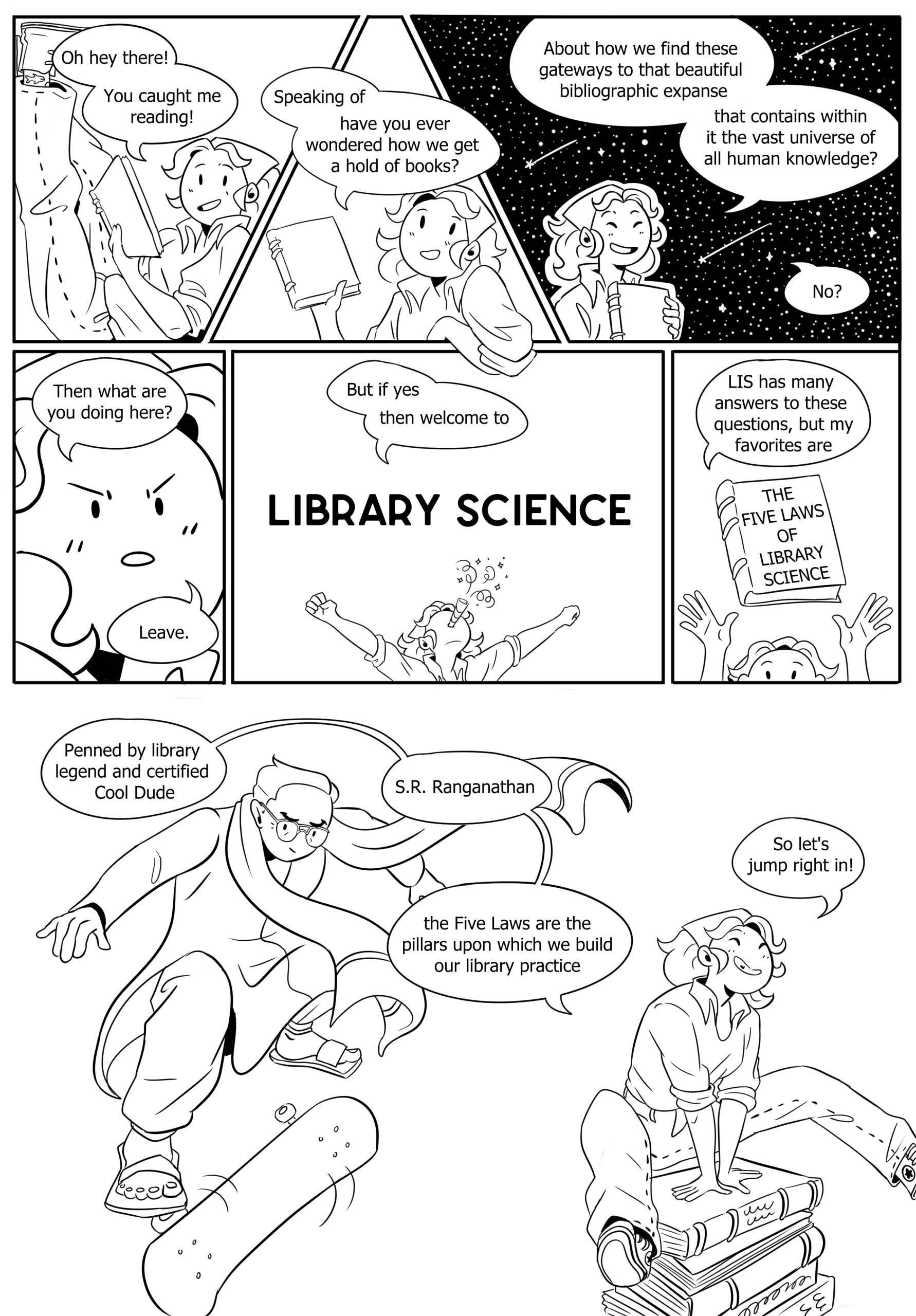6 The Five Laws of Library Science in Five Panels or Less
Audrey Bentch
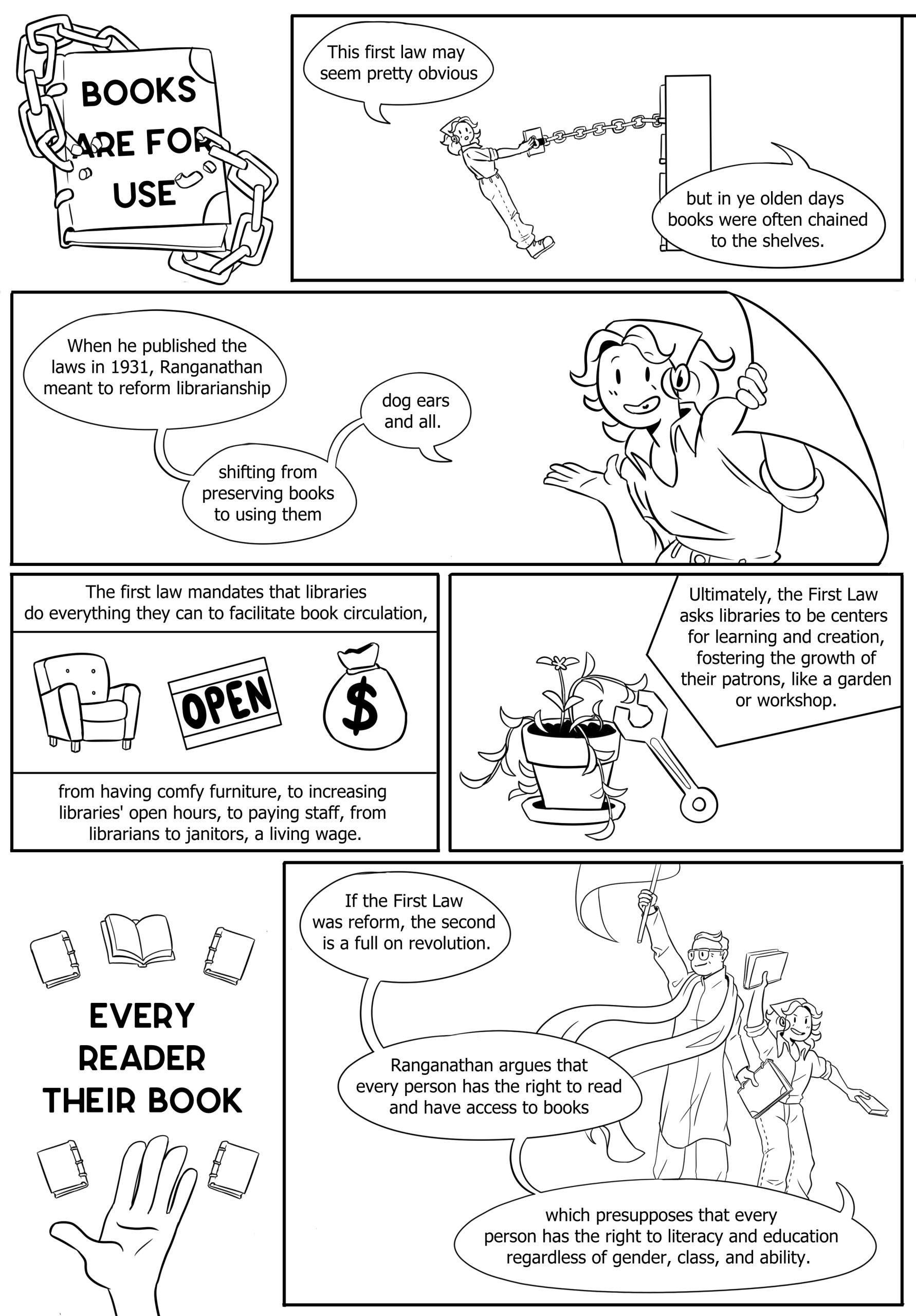
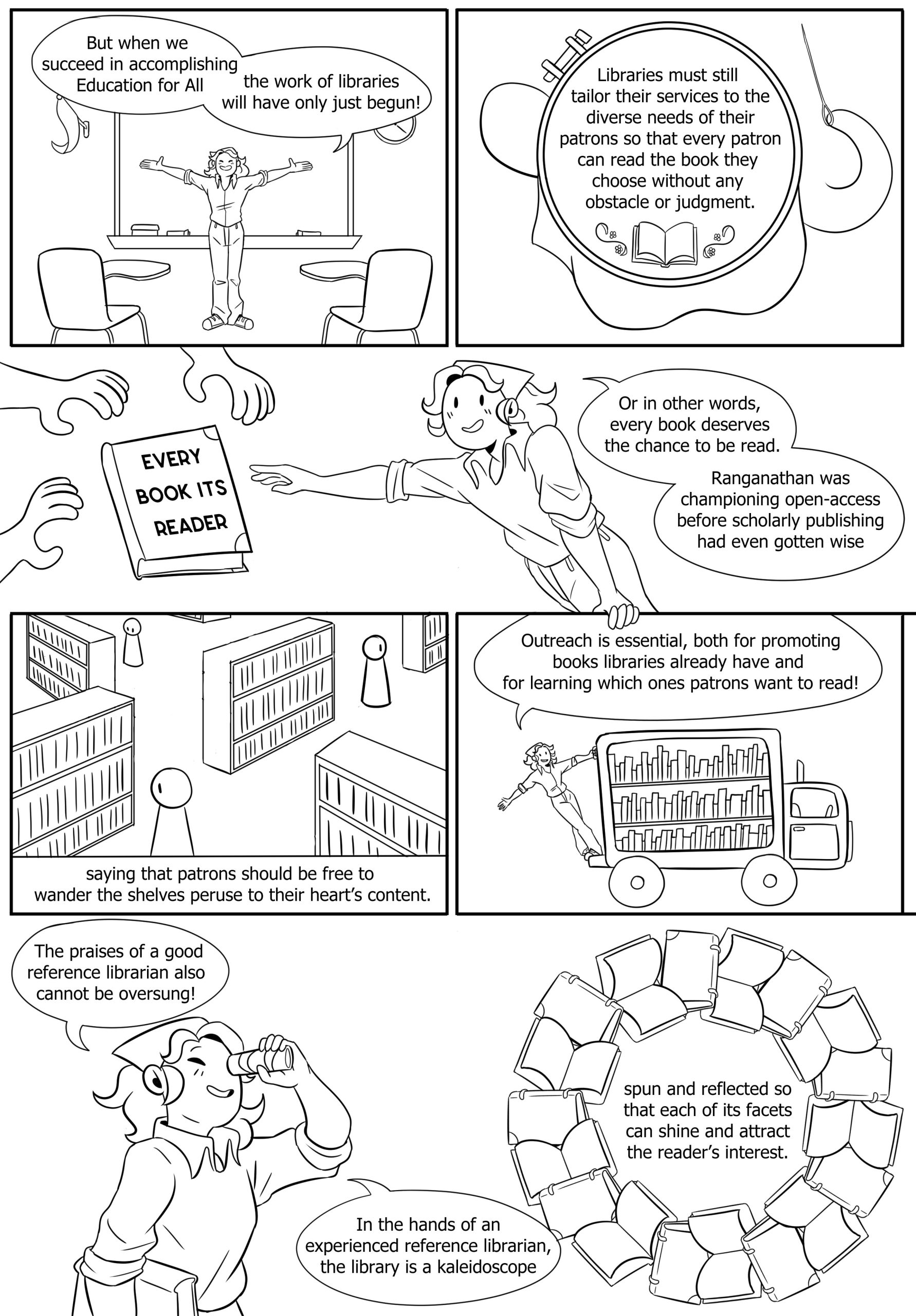
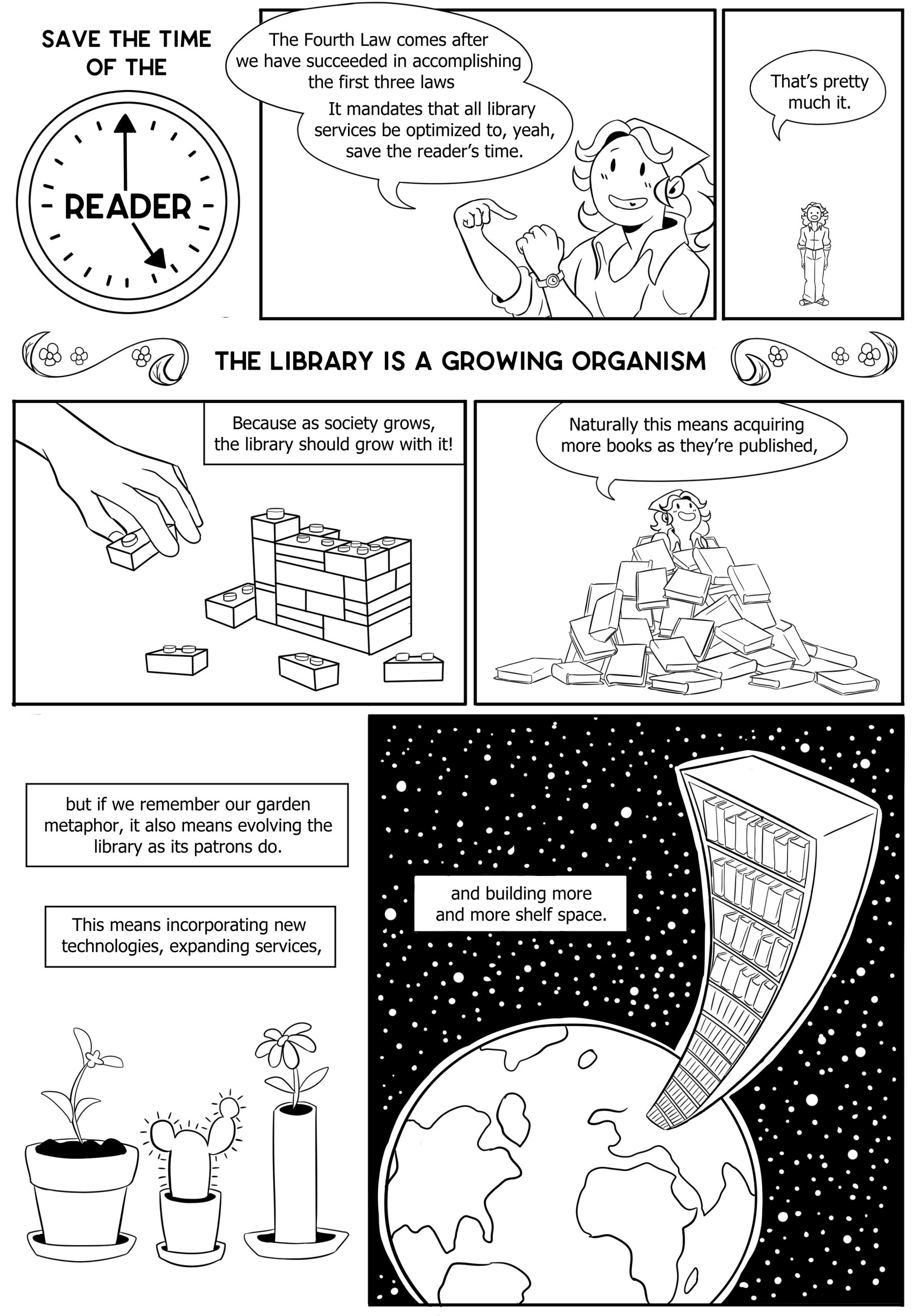
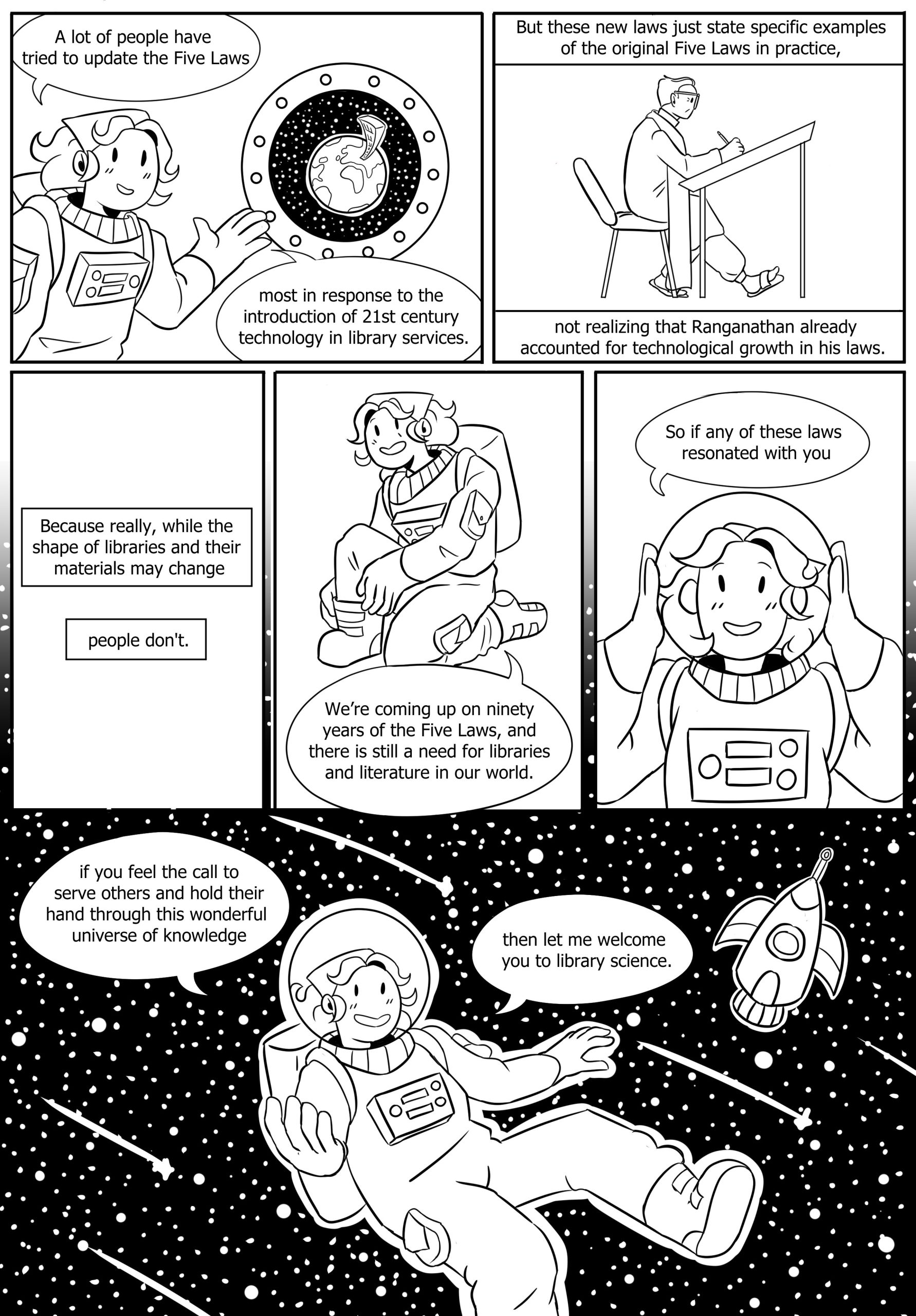
Comic Transcript and Description
Page 1:
Panel 1: A cartoon librarian reads a book with her feet propped up on the panel border. She says, “Oh hey there! You caught me reading!”
Panel 2: The librarian holds up the books and continues, “Speaking of, have you ever wondered how we get a hold of books?”
Panel 3: The librarian suddenly stands against a starry night sky, where she elaborates, “About how we find these gateways to that beautiful bibliographic expanse that contains within it the vast universe of all human knowledge?”
Panel 4: A cut to a close-up of the librarian’s angry face. She says, “Then what are you doing here? Leave.”
Panel 5: The librarian blows on a party streamer with her arms outstretched. “But if yes, then welcome to library science!”
Panel 6: “LIS has many answers to these questions, but my favorites are The Five Laws of Library Science.” The librarian holds up a book with that title.
Panel 7: A cartoon representation of librarian S.R. Ranganathan does a sick kickflip. The librarian explains, “Penned by library legend and Cool Dude S.R. Ranganathan, the Five Laws are the pillars upon which we build our library practice.” The librarian leap frogs over a pile of books. “So let’s jump right in!”
Page 2
Panel 1: A book surrounded by a broken chain that is titled “BOOKS ARE FOR USE.”
Panel 2: The librarian yanks at a book chained to a bookshelf and says, “The first law may seem pretty obvious, but in ye olden days books were often chained to the shelves.”
Panel 3: The librarian tugs at the panel border, folding it like a dog-eared page as she says, “When he published the laws in 1931, Ranganathan meant to reform librarianship, shifting from preserving books to using them, dog ears and all.”
Panel 4: “The first law mandates that libraries do everything they can to facilitate book circulation, from having comfy furniture, to increasing libraries’ open hours, to paying staff, from librarians to janitors, a living wage.” Accompanying the text is a sofa, an “OPEN” sign, and a bag of money.
Panel 5: A wrench rests against a potted plant. “Ultimately, the First Law asks libraries to be centers of learning and creation, fostering the growth of their patrons, like a garden or workshop.”
Panel 6: A hand reaches up to a circle of books that encircle the text, “EVERY READER THEIR BOOK.”
Panel 7: Ranganathan stands holding a book and a flag, with the librarian standing next to him, in the style of “Liberty Leading the People” by Eugène Delacroix. The librarian says, “If the First Law was reform, the second is a full on revolution. Ranganathan argues that every person has the right to read and have access to books, which presupposes that every person has the right to literacy and education regardless of gender, class, and ability.”
Page 3
Panel 1: The librarian stands with her arms outstretched at the front of a classroom, exclaiming, “But when we succeed in accomplishing Education for All, the work of libraries will have only just begun!”
Panel 2: An embroidery hoop encircles the following text, “Libraries must still tailor their services to the diverse needs of their patrons so that every patrons can read the book they choose without any obstacle or judgement.”
Panel 3: Three hands reach for a book titled, “EVERY BOOKS ITS READER.” The librarian also reaches for the book as she says, “Or in other words, every book deserves to the chance to be read. Ranganathan was championing open-access before scholarly publishing had even gotten wise.”
Panel 4: Library patrons peruse library shelves in an open space. The text continues from the previous panel, “saying that patrons should be free to wander the shelves and peruse to their heart’s content.”
Panel 5: The librarian holds on to a truck filled with books and says, “Outreach is essential, both for promoting books libraries already have and for learning which ones patrons want to read!”
Panel 6: The librarian holds a kaleidoscope up to her eye and says, “The praises of a good reference librarian also cannot be oversung! In the hands of an experienced reference librarian, the library is a kaleidoscope.”
Panel 7: A ring of books encircles the text, “spun and reflected so that each of its facets can shine and attract the reader’s interest.”
Page 4
Panel 1: A clock displays the text, “SAVE THE TIME OF THE READER.”
Panel 2: The librarian points to a wristwatch and says, “The Fourth Law comes after we have succeeded in accomplishing the first three laws. It mandates that all library services be optimized to, yeah, save the reader’s time.”
Panel 3: The librarian stands small in an empty panel and says, “That’s pretty much it.”
Panel 4: The text, “THE LIBRARY IS A GROWING ORGANISM” is bordered by vines and flowers.
Panel 5: A hand grabs a Lego brick from a stack of bricks. “Because as society grows, the library should grow with it!”
Panel 6: The librarian sticks her head out from a giant pile of books, exclaiming, “Naturally this means acquiring more books as they’re published.”
Panel 7: Three potted plants sit in an empty panel with the text, “But if we remember our garden metaphor, it also means evolving the library as its patrons do. This means incorporating new technologies, expanding services,”
Panel 8: The text continues against the background of a bookshelf extending from Earth into the atmosphere, “and building more and more shelf space.”
Page 5
Panel 1: The librarian looks upon the Earth from a porthole, wearing a spacesuit. She says, “A lot of people have tried to update the Five Laws, most in response to the introduction of 21st century technology in library services.”
Panel 2: Ranganathan sits at his desk as the librarian continues, “But these new laws just state specific examples of the original Five Laws in practice, not realizing that Ranganathan already accounted for technological growth in his laws.”
Panel 3: The text stands in an empty panel, “Because really, while the shape of libraries and their materials may change, people don’t.”
Panel 4: The librarian puts on a space boot and says, “We’re coming up on ninety years of the Five Laws, and there is still a need for libraries and literature in our world.”
Panel 5: The librarian puts on a space helmet. “So if any of these laws resonated with you,”
Panel 6: The librarian floats in space, tethered to her rocket ship and extending her hand to say, “if you feel the call to serve others and hold their hand through this wonderful universe of knowledge, then let me welcome you to library science.”
References and Further Reading
- Ranganathan, S. R. (Shiyali Ramamrita). The Five Laws of Library Science. Bombay, New York: Asia Pub. House, 1963.
- The Five Laws of Library Science is Ranganathan’s original publication of the Five Laws, in which he describes the theories behind the laws and their practical application. Elements of his rhetoric include analyses of librarianship country to country and fictional dialogues between the laws and opposing practices.
- Zabel, Diane, & Emily Rimland. “Ranganathan’s Relevant Rules.” Reference & User Services Quarterly, 46.4 (2007): 24-26.
- Provides a brief explanation of the Five Laws and their relevancy in the 21st century.
- Simpson, Carol. “EDITOR’S Notes.” Library Media Connection, 26.7 (2008): 6.
- In response to the broader inclusion of non-print materials in library catalogs, Simpson proposes these revisions to the Five Laws:
- Media are for use.
- Every patron his information.
- Every medium its user.
- Save the time of the patron.
- The library is a growing organism.
- In response to the broader inclusion of non-print materials in library catalogs, Simpson proposes these revisions to the Five Laws:
- Noruzi, A. (2004). “Application of Ranganathan’s Laws to the Web.” Webology, 1(2), Article 8.
- Noruzi tracks the history of the Five Laws within the library discipline and discusses them in relation to the developing internet, proposing his own Five Laws of the Web:
- Web resources are for use.
- Every user his or her web resource.
- Every web resource its user.
- Save the time of the user.
- The Web is a growing organism.
- Noruzi tracks the history of the Five Laws within the library discipline and discusses them in relation to the developing internet, proposing his own Five Laws of the Web:
- Shadrach, B. “S R Ranganthan’s Five Laws of Library Science: A Foundation for Democratising Knowledge.” Informatics Studies IS 6.2 (2019): 33–36.
- Shadrach argues for an even stronger revolutionary reading of the Five Laws, crediting Ranganthan for his advocacy for open-access and non-discrimination which contributed to the success of today’s knowledge based society. He further refines the Five Laws to encompass the current knowledge culture:
- Knowledge is for use in “all” forms.
- “Every citizen” has the right to access “all” forms of knowledge.
- Every knowledge is for access by “all” without discrimination of any kind.
- Save the time of “all” knowledge seekers.
- A knowledge system is one that evolves with time to achieve all of the above laws.
- Shadrach argues for an even stronger revolutionary reading of the Five Laws, crediting Ranganthan for his advocacy for open-access and non-discrimination which contributed to the success of today’s knowledge based society. He further refines the Five Laws to encompass the current knowledge culture:
- Connaway, Lynn Silipigni, and Ixchel M. Faniel. “Reordering Ranganathan: Shifting User Behaviors, Shifting Priorities.” Dublin, OH: OCLC Research, 2014.
- The above report provides an in-depth analysis of the Five Laws in modern librarianship, in which the authors maintain the relevancy of the Five Laws but explore possible reinterpretations and applications.
Reflection Exercises and Questions
- Consider how you would visualize the Five Laws and attempt an illustration of one. What visual elements do you incorporate? How does it overlap with typical library iconography?
- Consider your own experiences as a library patron. Do you feel that the Five Laws were properly implemented in libraries that you have used? Are there any specific library services that you recognize as expressions of the Five Laws?
- Take a look at some of the attempts to revise the Five Laws. Do you believe that these modern updates would benefit library practice? Or are these revisions redundant/already intrinsic to the original Five Laws?
- Are there any laws that you believe Ranganthan missed? What would they be, and how might you visualize them?



